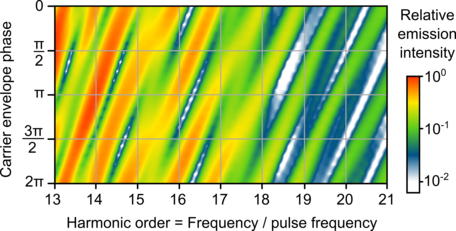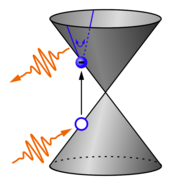
Ultrafast dynamics and High-Harmonic Generation in Solids
Recent progress in laser technology made it possible to generate ultra-short laser pulses on the femtosecond timescale with high intensity. When irradiating a solid with such a pulse, electrons are excited from valence bands to conduction bands.
The electric field of the laser pulse is typically described by a Gaussian, modulated with an oscillating frequency ω [1],
E(t) = E0 cos(ωt + φ) exp(−t²/σ²) . (1)
From a driven harmonic oscillator, we expect the charge density in the solid to also oscillate with a frequency ω as response to the electric field. However, the electron charge density oscillates not only with frequency ω, but also with higher frequencies nω, n∈N, which is due to multiple excitations of electrons between the bands and due to acceleration of already excited electrons by the electric field E(t). Consequently, the emitted radiation by the charge density movement features high-harmonic frequencies nω, where n>20 can be observed. Together with Prof. Huber's group and Prof. Richter's group, we are working on ultrafast electron dynamics and high-harmonic generation from topological surface states [1].
High-harmonic emission from a topological surface state is particularly intense because of the Dirac-type bandstructure and shows a distinct dependence on the carrier envelope phase (CEP) φ, see equation (1). [1] As shown below, we calculate the CEP dependence of the emitted radiation using semiconductor Bloch equations [2] as implemented in our open-source code CUED that is freely available on github.


[1] C. P. Schmid, L. Weigl, P. Grössing, V. Junk, C. Gorini, S. Schlauderer, S. Ito, N. Hofmann, D. Afanasiev, J. Crewse, K. A.Kokh, O. E. Tereshchenko, J. Güdde, F. Evers, J. Wilhelm, K. Richter, U. Höfer, and R. Huber: Tunable non-integer high-harmonic generation in a topological insulator, Nature 593, 385-390 (2021).
[2] J. Wilhelm, P. Grössing, A. Seith, J. Crewse, M. Nitsch, L. Weigl, C. Schmid, F. Evers: Semiconductor Bloch-equations formalism: Derivation and application to high-harmonic generation from Dirac fermions, Phys. Rev. B 103, 125419 (2021).

